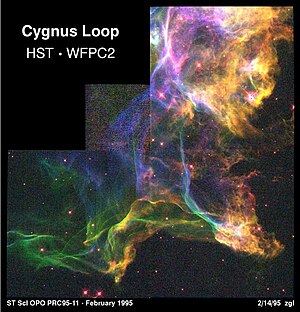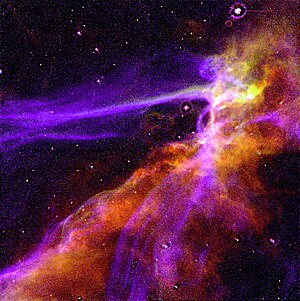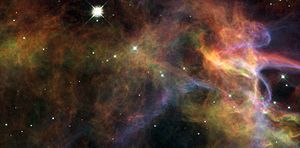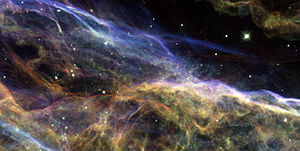Cygnus Loop
Cygnus Loop
Jump to navigation
Jump to search
The Cygnus Loop (radio source W78, or Sharpless 103) is a large supernova remnant (SNR) in the constellation Cygnus, an emission nebula measuring nearly 3° across.[1] Some arcs of the loop, known collectively as the Veil Nebula or Cirrus Nebula, emit in the visible electromagnetic range.[1] Radio, infrared, and X-ray images reveal the complete loop.
Contents
1 Visual components: the Veil Nebula
1.1 NGC 6960
1.2 NGC 6992, NGC 6995, and IC 1340
1.3 Pickering's Triangle
1.4 NGC 6974 and NGC 6979
2 Southeastern knot
3 Distance
4 Astronomical ultraviolet source
5 X-ray source
6 Fiction
7 See also
8 References
9 External links
Visual components: the Veil Nebula[edit]
The visual portion of the Cygnus Loop is known as the Veil Nebula, also called the Cirrus Nebula or the Filamentary Nebula. Several components have separate names and identifiers,[2][3] including the "Western Veil" or "Witch's Broom", the "Eastern Veil", and Pickering's Triangle.
NGC 6960[edit]
NGC 6960, the Western Veil, is the western part of the remnant, also known as the "Witch's Broom", located at J2000 RA 20h 45m 58.1sDec +30° 35′ 43″.[3] As the western-most NGC object in the nebula (first in right ascension), its number is sometimes used as an NGC identifier for the nebula as a whole.
NGC 6992, NGC 6995, and IC 1340[edit]
These three luminous areas make up the Eastern Veil. NGC 6992 is an HI shell located along the north-eastern edge of the loop at J2000 RA 20h 56m 19.0sDec +31° 44′ 34″.[4] NGC 6995 is located farther south at J2000 RA 20h 57m 10.7sDec +31° 14′ 07″,[5] and IC 1340 even farther south at J2000 RA 20h 56m 12.0sDec +31° 04′ 00″.[6]
Pickering's Triangle[edit]
Also known as Pickering's Wedge, or Pickering's Triangular Wisp, this segment of relatively faint nebulosity was discovered photographically in 1904 by Williamina Fleming at Harvard Observatory, where Edward Charles Pickering was director at the time. The Triangle is brightest along the northern side of the loop, though photographs show the nebulosity extending into the central area as well.
NGC 6974 and NGC 6979[edit]
These two objects are generally identified today (as by the NGC/IC Project and Uranometria) with two brighter knots of nebulosity in a cloud at the northern edge of the loop, to the east of the northern edge of Pickering's Triangle. NGC 6979 was reported by William Herschel, and while the coordinates he recorded for Veil objects were somewhat imprecise,[7] his position for this one is tolerably close to the knot at J2000 RA 20h 50m 27.9sDec +32° 01′ 33″.[7]
The identifier NGC 6979 is sometimes taken to refer to Pickering's Triangle,[8] but the Triangle is probably not what Herschel saw or what the Catalogue intended for this entry: it was discovered only photographically, after the Catalogue was published, and long after Herschel's observation.
NGC 6974 was reported by Lord Rosse, but the position he gave lies in an empty region inside the main loop. It was assumed that he recorded the position incorrectly, and the New General Catalogue gives Rosse's object as the other knot in the northern cloud, located at J2000 RA 20h 51m 04.3sDec +31° 49′ 41″, one degree north of Rosse's position.[9] (This position is farther east than NGC 6979, even though NGC objects are generally ordered by increasing RA.) These filaments in the north-central area are sometimes known as the "carrot".[10] The spectrum at 34.5 MHz of the region associated with NGC 6974 ranges straight over the entire frequency range 25 to 5000 MHz.[11]
Southeastern knot[edit]
The southeastern knot is located at J2000 RA 20h 56m 21.2sDec +30° 23′ 59″ on the southeastern rim of the Cygnus Loop. The knot has been identified as an encounter between the blast wave from the supernova and a small isolated cloud.[12] The knot is a prominent X-ray feature, consisting of a number of filaments correlated with visual line emission.[12] By combining visual and X-ray data, it can be shown that the southeastern knot is an indentation on the surface of the blast wave, not a small cloud but the tip of a larger cloud.[12] The presence of a reverse shock is evidence that the knot represents an early stage of a blast wave encountering a large cloud.[12]
Distance[edit]
Until recently, the distance to the supernova remnant was estimated at about 770 parsecs or 2500 light-years.[13][14] Recent studies, however, have shown that it must be closer. In 1999, William Blair, assuming that the shock wave should be expanding at the same rate in all directions, compared the angular expansion along the sides of the bubble (visible in Hubble Space Telescope images) with direct line-of-sight measurements of the radial expansion towards the Earth.[13] He concluded that the actual size of the bubble was about 40% smaller than the conventional value, leading to a distance of about 1470 ly.[13][14]
This revised calculation, though it involved some uncertainty and was met with some resistance,[14] has been substantially corroborated by the discovery via the Far Ultraviolet Spectroscopic Explorer (FUSE) of a star behind the Veil. The star, KPD2055+3111, of spectral type sdOBwas, was identified as UV-bright in an image from the Ultraviolet Imaging Telescope,[15] and absorption lines in its spectrum indicate that its light is partially intercepted by the supernova remnant.[14] The emission properties of the star indicate that it lies about 1860 ly away,[14] giving an upper bound for the distance of the loop and supporting the previous estimate of 1470 ly.
The revised distance in turn yields revised estimates of the size of the remnant (to 90 ly, down from 150 ly previously)[14] and for its age (now thought to be between 5000 and 8000 years).[14]
Astronomical ultraviolet source[edit]

Ultraviolet view of Cygnus loop
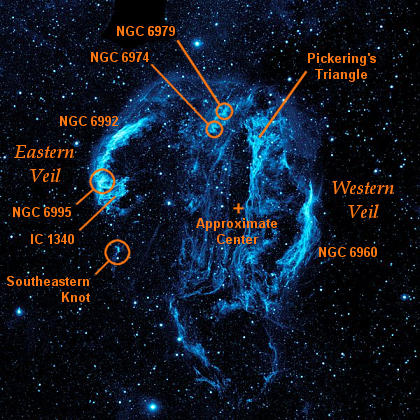
Prominent features of the Cygnus loop
The brightest far-ultraviolet sources of the Cygnus Loop occur in the north-east edge of the remnant. The first flight of the High Resolution Emission Line Spectrometer (HIRELS), a wide-field, far-ultraviolet nebular spectrometer, tuned to OVI emission lines, was launched aboard a Nike-Black Brant from White Sands Missile Range to observe the Cygnus Loop, the first observed galactic OVI emission line source.[16]
X-ray source[edit]
The X-ray source Cygnus X-5 coincides with SNR G074.0-08.6 (the Cygnus Loop), located at J2000 RA 20h 51.1mDec +30° 41′, observed by Uhuru at 4U 2046+31. This source also has catalogue numbers 1E 2049.4+3050, 1H 2050+310, and 1M 2051+309, having been observed by the Einstein Observatory, HEAO 1, and OSO 7, respectively.
The Cygnus Loop is a strong source of soft X-rays.[17]
The center of the supernova shell as determined from X-ray data lies at J1950 RA 20h 49m 45sDec +30° 53′.[18] A characteristic thermal temperature averaged over the loop from X-ray spectral data is Tx = 2.9 ± 1.5 x 106 K.[18] An X-ray surface brightness map of the loop was obtained with a one-dimensional X-ray telescope flown aboard an Aerobee 170 sounding rocket launched on March 30, 1973, from the White Sands Missile Range.[18]
Fiction[edit]
In the novel Mindbridge by Joe Haldeman, the Cygnus Loop is the remains of the home star of an omnipotent, immortal race that ultimately decided to destroy itself.
See also[edit]
- X-ray astronomy
- Radio astronomy
- Ultraviolet astronomy
References[edit]
^ ab Murdin P (2001). "Cygnus Loop". In Murdin P. Encyclopedia of Astronomy and Astrophysics. Bristol: Institute of Physics. Article 5297..mw-parser-output cite.citation{font-style:inherit}.mw-parser-output q{quotes:"""""""'""'"}.mw-parser-output code.cs1-code{color:inherit;background:inherit;border:inherit;padding:inherit}.mw-parser-output .cs1-lock-free a{background:url("//upload.wikimedia.org/wikipedia/commons/thumb/6/65/Lock-green.svg/9px-Lock-green.svg.png")no-repeat;background-position:right .1em center}.mw-parser-output .cs1-lock-limited a,.mw-parser-output .cs1-lock-registration a{background:url("//upload.wikimedia.org/wikipedia/commons/thumb/d/d6/Lock-gray-alt-2.svg/9px-Lock-gray-alt-2.svg.png")no-repeat;background-position:right .1em center}.mw-parser-output .cs1-lock-subscription a{background:url("//upload.wikimedia.org/wikipedia/commons/thumb/a/aa/Lock-red-alt-2.svg/9px-Lock-red-alt-2.svg.png")no-repeat;background-position:right .1em center}.mw-parser-output .cs1-subscription,.mw-parser-output .cs1-registration{color:#555}.mw-parser-output .cs1-subscription span,.mw-parser-output .cs1-registration span{border-bottom:1px dotted;cursor:help}.mw-parser-output .cs1-hidden-error{display:none;font-size:100%}.mw-parser-output .cs1-visible-error{font-size:100%}.mw-parser-output .cs1-subscription,.mw-parser-output .cs1-registration,.mw-parser-output .cs1-format{font-size:95%}.mw-parser-output .cs1-kern-left,.mw-parser-output .cs1-kern-wl-left{padding-left:0.2em}.mw-parser-output .cs1-kern-right,.mw-parser-output .cs1-kern-wl-right{padding-right:0.2em}
[permanent dead link]
^ "SEDS Online NGC Catalog". Results for Veil Nebula. Retrieved 2010-12-01.
^ ab "NGC/IC Project". Results for NGC 6960. Retrieved 2010-12-01.
^ "NGC/IC Project". Results for NGC 6992. Retrieved 2010-12-01.
^ "NGC/IC Project". Results for NGC 6995. Retrieved 2010-12-01.
^ "NGC/IC Project". Results for IC 1340. Retrieved 2010-12-01.
^ ab "NGC/IC Project". Results for NGC 6979. Retrieved 2010-12-01.
^ See, for example, this photo posted by Astronomy Magazine (accessed 2010-12-01).
^ "NGC/IC Project". Results for NGC 6974. Retrieved 2010-12-01.
^ Greidanus H; Strom RG (1992). "Optical kinematics in the Cygnus Loop. II - Interpretation". Astron. Astrophys. 257 (1): 265–77. Bibcode:1992A&A...257..265G.
^ Sastry CV; Dwarakanath KS; Shevgaonkar RK (Sep 1981). "The structure of the Cygnus loop at 34.5 MHz". J. Astrophys. Astron. 2 (3): 339–47. Bibcode:1981JApA....2..339S. doi:10.1007/BF02714557.
^ abcd Graham JR; Levenson NA; Hester JJ; Raymond JC; et al. (May 1995). "An X-ray and optical study of the interaction of the Cygnus Loop supernova remnant with an interstellar cloud". Astrophys. J. 444 (5): 787–95. Bibcode:1995ApJ...444..787G. doi:10.1086/175651.
^ abc "Astro News Briefs: June 14–20 [2004]". Sky & Telescope. Retrieved 2010-12-03.
^ abcdefg William Blair. "Piercing the Veil". FUSE Science Summaries. Archived from the original on 2012-12-11. Retrieved 2010-12-03.
^ Blair WP; Sankrit R; Torres SI; Chayer P; et al. (Jun 2004). "FUSE Observations of a Star Behind the Cygnus Loop". Bull Am Astron Soc. 36 (2).
^ Rasmussen A; Martin C (Sep 1990). "Cygnus Loop: The First Observed Galactic OVI Emission Line Source". Bull Am Astron Soc. 22 (9): 1272. Bibcode:1990BAAS...22R1272R.
^ Fesen RA; Blair WP; Kirshner RP (Nov 1982). "Spectrophotometry of the Cygnus Loop". Astrophys. J. 262 (12): 171–88. Bibcode:1982ApJ...262..171F. doi:10.1086/160408.
^ abc Rappaport S; Doxsey R; Solinger A; Borken R (Dec 1974). "X-ray structure of the Cygnus loop". Astrophys. J. 194 (12): 329–35. Bibcode:1974ApJ...194..329R. doi:10.1086/153249.
External links[edit]
- Sharpless Catalog 103
"FUSE Pierces the Veil". Newswise. Retrieved 2010-12-03.
- The Cygnus Loop on WikiSky: DSS2, SDSS, GALEX, IRAS, Hydrogen α, X-Ray, Astrophoto, Sky Map, Articles and images
Cygnus Loop image from NOAO, in one of the largest astronomical images yet made (universetoday.com).- Cygnus Loop in ultraviolet light
The loop at 1420 mhz Source
Categories:
- Supernova remnants
- X-ray astronomy
- Astronomical X-ray sources
- Cygnus (constellation)
- Sharpless objects
(window.RLQ=window.RLQ||).push(function(){mw.config.set({"wgPageParseReport":{"limitreport":{"cputime":"0.452","walltime":"0.542","ppvisitednodes":{"value":2060,"limit":1000000},"ppgeneratednodes":{"value":0,"limit":1500000},"postexpandincludesize":{"value":50146,"limit":2097152},"templateargumentsize":{"value":1452,"limit":2097152},"expansiondepth":{"value":12,"limit":40},"expensivefunctioncount":{"value":3,"limit":500},"unstrip-depth":{"value":1,"limit":20},"unstrip-size":{"value":49849,"limit":5000000},"entityaccesscount":{"value":2,"limit":400},"timingprofile":["100.00% 404.126 1 -total"," 61.28% 247.649 1 Template:Reflist"," 18.14% 73.290 7 Template:Cite_journal"," 15.53% 62.771 1 Template:Cite_book"," 11.83% 47.797 10 Template:Cite_web"," 11.68% 47.183 1 Template:External_media"," 9.38% 37.910 1 Template:Dead_link"," 8.28% 33.468 1 Template:Infobox"," 8.18% 33.073 1 Template:Fix"," 7.49% 30.266 1 Template:Main"]},"scribunto":{"limitreport-timeusage":{"value":"0.204","limit":"10.000"},"limitreport-memusage":{"value":4911259,"limit":52428800}},"cachereport":{"origin":"mw1266","timestamp":"20181023004750","ttl":1900800,"transientcontent":false}}});mw.config.set({"wgBackendResponseTime":645,"wgHostname":"mw1266"});});
